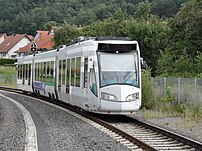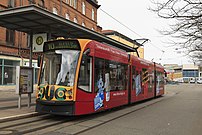A tram-train is a type of light rail vehicle that both meets the standards of a light rail system, and also national mainline standards. Tramcars are adapted to be capable of running on streets like an urban tramway but also be permitted operation alongside mainline trains. This allows services that can utilise both existing urban light rail systems and mainline railway networks and stations. It combines the urban accessibility of a tram or light rail with a mainline train's greater speed in the suburbs.[1]
The modern tram-train concept was pioneered by the German city of Karlsruhe in the late 1980s,[2] resulting in the creation of the Karlsruhe Stadtbahn. This concept is often referred to as the Karlsruhe model,[1] and it has since been adopted in other cities such as Mulhouse in France[1] and in Kassel, Nordhausen and Saarbrücken in Germany.[2]
An inversion of the concept is a train-tram – a mainline train adapted to run on-street in an urban tramway, also known as the Zwickau Model.
- ^ a b c "Tram-train: Making new connections". tautonline.com. Tramways & Urban Transit. Retrieved 28 January 2022.
- ^ a b "Uk tram-train: Learning lessons". tautonline.com. Tramways & Urban Transit. Retrieved 28 January 2022.







